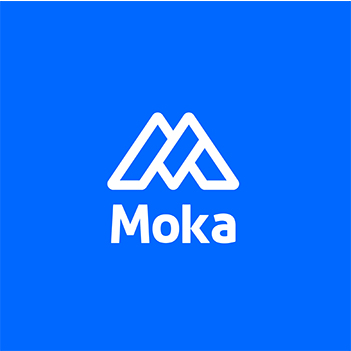Onboarding Automation Software: The Future of Employee Integration and Retention
Introduction
Onboarding Automation Software is a digital solution designed to streamline and optimize the employee onboarding process by automating key tasks such as document management, training assignment, and compliance tracking. It eliminates repetitive administrative work, reduces manual errors, and ensures a consistent onboarding experience across all departments.
In the context of Singapore, where regulatory frameworks like the Personal Data Protection Act (PDPA) demand stringent data management practices, onboarding automation has become increasingly relevant. According to a 2024 report by HR Tech SG, 65% of Singaporean companies have already implemented onboarding automation to enhance data security and compliance.
Successful implementation of onboarding automation has been linked to increased employee retention rates. For instance, a Deloitte study found that companies utilizing AI-driven onboarding software reported a 30% reduction in employee turnover within the first six months of hire. Additionally, DBS and Singtel, two of Singapore's leading employers, have leveraged automated onboarding platforms to provide personalized learning paths for new hires, resulting in a 25% increase in employee satisfaction within the first 90 days.
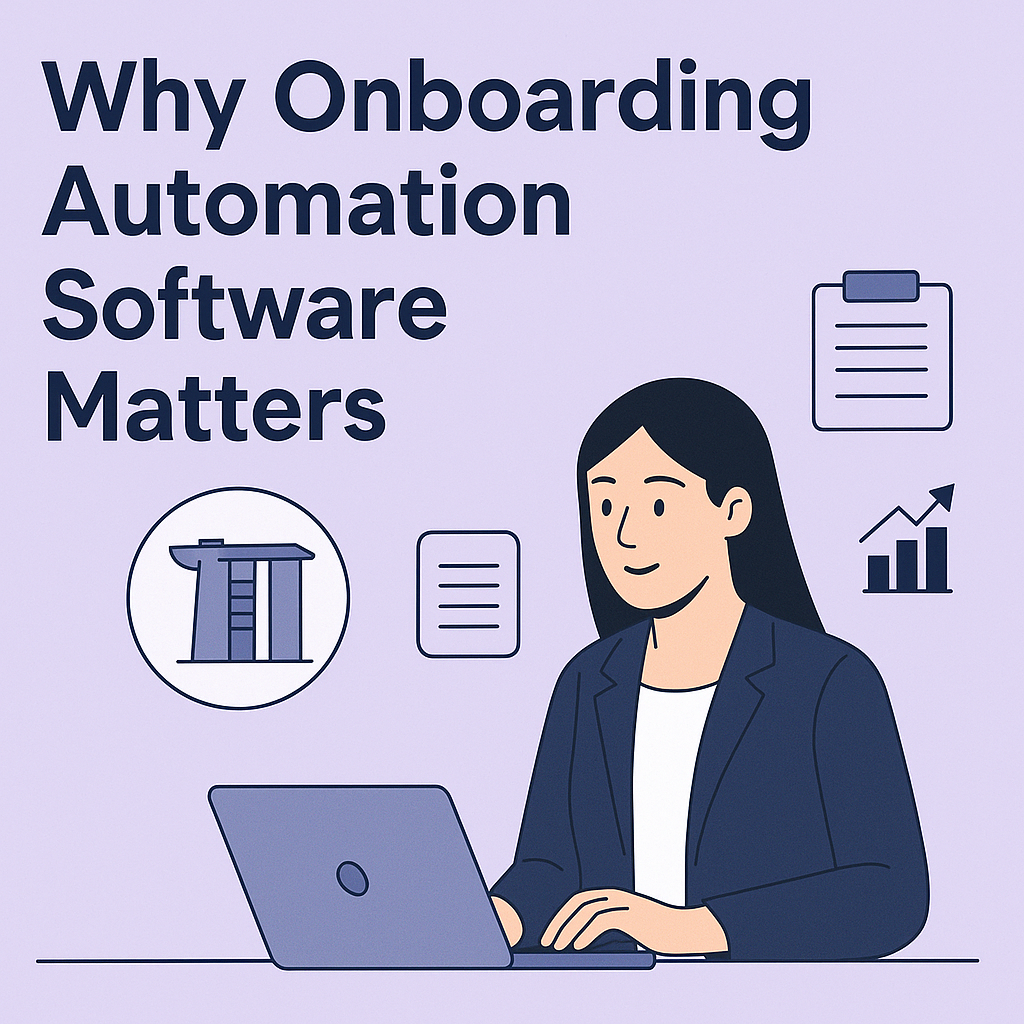
The onboarding process is no longer just a procedural formality—it’s a strategic opportunity to shape the employee experience and drive organizational success. In Singapore’s dynamic HR landscape, where regulatory compliance and digital transformation are key priorities, Onboarding Automation Software has emerged as a vital asset. Beyond reducing manual tasks, it integrates advanced analytics, personalized learning paths, and data-driven insights to ensure that every new hire’s journey aligns with company goals while adhering to the Personal Data Protection Act (PDPA). As more companies in Singapore compete for top talent, optimizing the onboarding process through automation has become essential for improving retention and fostering a strong workplace culture.
In Singapore's rapidly evolving HR landscape, Onboarding Automation Software has become a crucial asset for companies striving to enhance employee integration and comply with stringent regulations such as the Personal Data Protection Act (PDPA). By streamlining onboarding processes through digital platforms, organizations can reduce manual work, minimize compliance risks, and improve new hire experiences. With Singapore’s competitive job market and rising demand for skilled talent, effective onboarding is not just a tactical necessity—it’s a strategic imperative. Onboarding Automation Software is reshaping the way companies manage new employee integration. By digitizing and streamlining onboarding processes, organizations can significantly reduce manual work, minimize errors, and improve new hire experiences. In today's competitive job market, effective onboarding is no longer a luxury but a strategic imperative.
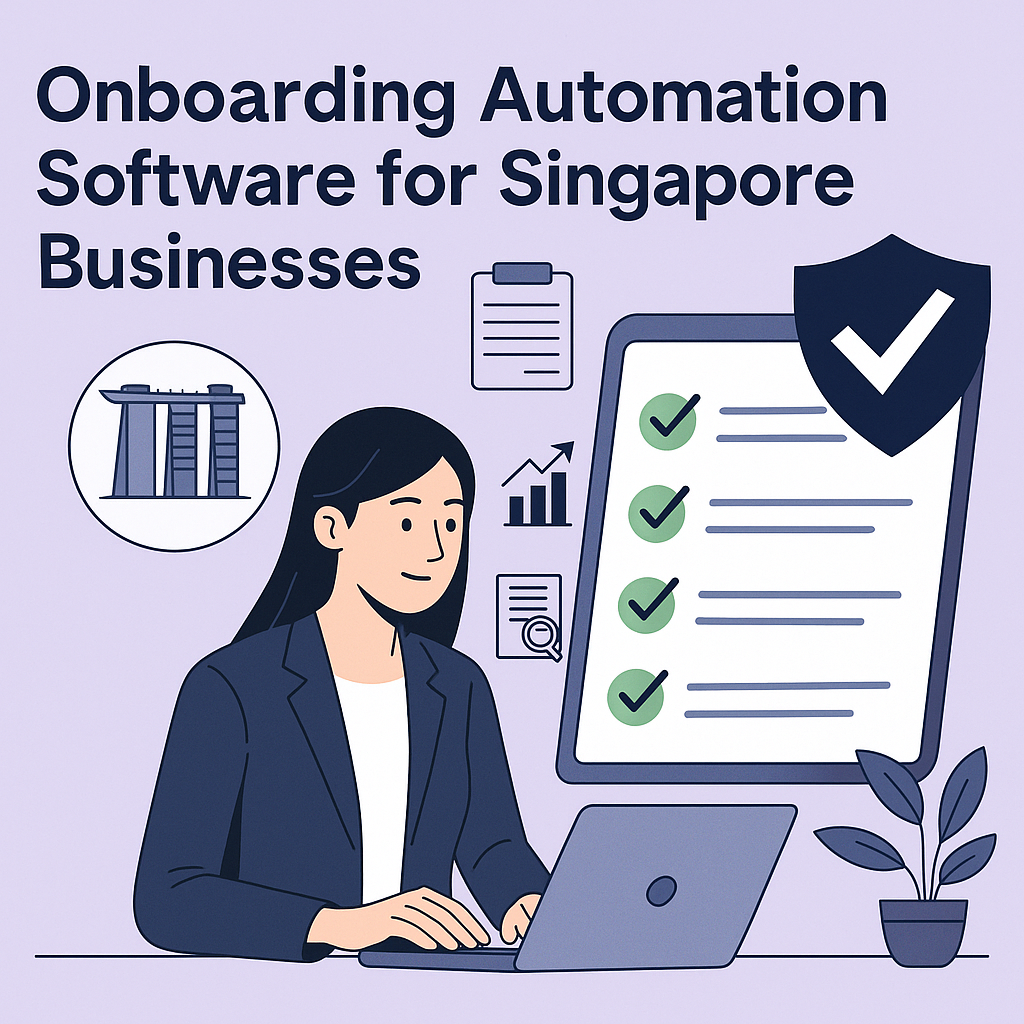
Key Features of Onboarding Automation Software
Digital Document Management: Automates the distribution and collection of key documents such as offer letters, NDAs, and tax forms.
Task Assignment and Tracking: Assigns onboarding tasks to relevant departments, ensuring no step is missed during the new hire process.
Training and Learning Modules: Integrates personalized training plans, compliance courses, and job-specific training modules.
Employee Self-Service Portal: Provides new hires with a centralized portal to access necessary resources, schedules, and company policies.
Compliance Management: Ensures legal and regulatory adherence, particularly in industries with strict data protection laws such as finance and healthcare.
Why Onboarding Automation Software Matters
Onboarding Automation Software is not just a tool; it's a strategic investment that addresses critical HR challenges, especially in fast-paced markets like Singapore. By implementing such software, companies can:
Optimize Operational Efficiency: Automating repetitive tasks such as document management, training module assignment, and compliance tracking can free up HR teams to focus on strategic initiatives. According to a report by Deloitte, automated onboarding can reduce processing time by up to 30%.
Ensure Compliance and Data Security: In regions like Singapore, where data privacy regulations under the Personal Data Protection Act (PDPA) are stringent, automated onboarding ensures secure data storage and controlled access to sensitive employee information. HR Tech SG found that 65% of Singaporean companies are investing in compliance-centric onboarding solutions to mitigate regulatory risks.
Improve Employee Experience and Retention: A well-structured onboarding process can significantly impact employee engagement and retention rates. Research by Gartner shows that companies utilizing AI-driven onboarding software reported a 40% increase in employee satisfaction within the first 90 days.
Support Hybrid and Remote Work Models: With remote work becoming more prevalent, onboarding software facilitates seamless integration for remote hires through digital learning paths, virtual orientations, and interactive feedback systems. For instance, companies like DBS and Singtel in Singapore have successfully implemented remote onboarding frameworks to maintain employee engagement across distributed teams.
Leverage Data-Driven Insights: Advanced onboarding platforms provide actionable insights into new hire progress, common bottlenecks, and areas for improvement. By analyzing these metrics, HR leaders can refine onboarding strategies to better align with business objectives and employee expectations.
Enhanced Efficiency: Reduces administrative burden by automating repetitive tasks.
Improved Data Accuracy: Minimizes manual errors and ensures consistent data entry.
Scalability: Supports rapid hiring without overburdening HR teams.
Employee Experience: Provides a structured, engaging onboarding journey, increasing retention.
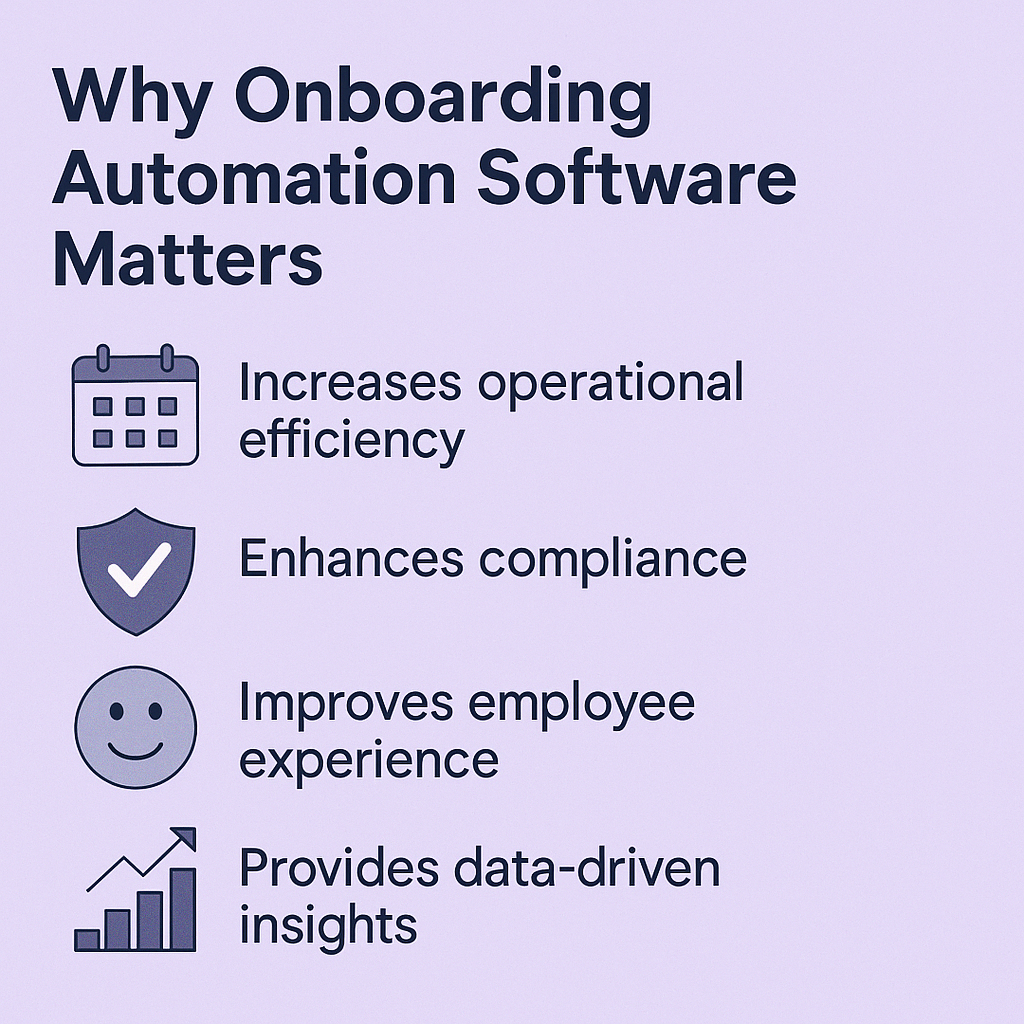
Industry Trends and Data
According to a 2024 report by HR Tech SG, 70% of companies in Singapore have adopted onboarding automation solutions, aiming to reduce onboarding time and improve compliance with PDPA.
A Deloitte study reveals that automated onboarding can reduce manual processing time by 30%, enabling HR teams to focus on strategic tasks rather than administrative work.
In industries such as finance and healthcare, onboarding automation software that integrates compliance checklists has led to a 35% decrease in regulatory violations, as reported by HR Asia. Source
According to a 2024 study by Gartner, 62% of companies reported improved employee retention after implementing onboarding automation. This highlights the growing importance of structured onboarding in retaining top talent.
Deloitte's HR Technology Priorities report for 2024 indicates that integrating AI into HR processes, including onboarding, can reduce onboarding time by 30% and significantly improve data accuracy.
HR Tech SG reports that companies utilizing AI-driven onboarding software experienced a 40% increase in employee engagement during the first 90 days, underscoring the impact of data-driven processes on employee satisfaction.
According to a 2024 study by Gartner, 62% of companies reported improved employee retention after implementing onboarding automation.
A Deloitte report found that automated onboarding reduced the average onboarding time by 30%, enabling quicker productivity ramp-up for new hires.
Companies leveraging AI-driven onboarding solutions experienced a 40% increase in employee engagement during the first 90 days.
Implementation Best Practices
Assess Current Onboarding Processes: Conduct a comprehensive audit of existing onboarding workflows to identify bottlenecks, redundancies, and opportunities for automation.
Stakeholder Alignment: Collaborate with HR, IT, and department leaders to define the onboarding objectives, KPIs, and desired outcomes.
Onboarding Templates: Develop standardized templates for offer letters, training schedules, compliance documents, and feedback forms to ensure consistency and legal compliance.
Digital Orientation Programs: Implement interactive orientation modules that provide an immersive experience for new hires, including company culture, role expectations, and support resources.
Feedback Loops: Establish mechanisms for gathering real-time feedback from new hires to assess the effectiveness of each onboarding stage and make continuous improvements.
Data Integration: Ensure seamless data flow between the onboarding software and other HR systems, such as ATS, HRIS, and LMS, to maintain data accuracy and streamline reporting.
Identify Key Touchpoints: Map out the entire onboarding journey, from preboarding to the first 90 days.
Integrate with Existing Systems: Ensure seamless data flow between the onboarding platform, ATS, and HRIS systems.
Customize Onboarding Plans: Tailor content to different roles, departments, and seniority levels.
Collect Feedback: Continuously monitor and adjust the onboarding process based on new hire feedback.
Common Challenges and Solutions
Compliance Complexities in Singapore: With the stringent PDPA regulations, ensuring data privacy during the onboarding process is critical.
Solution: Implement robust data encryption and secure document storage to safeguard sensitive employee information.
Multilingual Onboarding: Singapore’s diverse workforce requires multilingual onboarding resources to ensure clarity and inclusivity.
Solution: Use customizable templates and automated translation tools to deliver consistent onboarding content across multiple languages.
Remote Onboarding for Hybrid Teams: With remote work becoming more prevalent in Singapore, maintaining employee engagement during virtual onboarding can be challenging.
Solution: Integrate video onboarding modules, virtual meet-and-greet sessions, and digital feedback loops to foster connection.
Onboarding Drop-off: Lack of engagement can lead to high drop-off rates during the onboarding phase. Solution: Use AI-driven analytics to monitor engagement and send targeted reminders to keep new hires on track.
Data Overload: New hires can feel overwhelmed with too much information at once. Solution: Segment onboarding content into digestible modules and provide a learning path that prioritizes critical information first.
Cross-Department Collaboration: Misaligned expectations between HR, IT, and department heads can disrupt the onboarding process. Solution: Develop a centralized communication platform that tracks each task and assigns ownership.
Regulatory Compliance: In industries like finance or healthcare, adhering to strict compliance standards is critical. Solution: Integrate compliance checklists within the onboarding software to ensure all legal and regulatory requirements are met.
Remote Onboarding Challenges: Remote hires may feel disconnected or isolated during the onboarding process. Solution: Incorporate virtual meet-and-greets, video introductions, and ongoing support check-ins to foster inclusion.
Data Integration: Use APIs and middleware to connect disparate systems.
Compliance Risks: Implement secure data storage solutions to protect sensitive information.
Engagement Gaps: Incorporate interactive elements like welcome videos and virtual Q&A sessions.
Future of Onboarding Automation Software in Singapore
AI and Predictive Analytics: AI will play a pivotal role in predicting potential drop-off points in the onboarding process, particularly for remote hires, and recommend targeted interventions to mitigate disengagement.
Data-Driven Personalization: Onboarding platforms will increasingly leverage AI to deliver personalized learning paths based on job roles, seniority, and identified skill gaps, aligning with Singapore’s focus on upskilling and talent development.
Compliance-Centric Design: With evolving data privacy regulations in Singapore, compliance-driven onboarding software will prioritize secure data handling, digital signatures, and automated audit trails.
Integration of HR Tech Ecosystems: Seamless integration with HRIS, ATS, and LMS systems will become a key differentiator, allowing HR teams to track onboarding progress and employee development in a centralized platform.
Onboarding Gamification: Incorporating gamified elements such as quizzes and role-based challenges can increase engagement, making onboarding more interactive and reducing information overload.
AI and Predictive Analytics: Advanced algorithms will analyze employee engagement data during onboarding to predict potential turnover risks and suggest interventions.
Data-Driven Personalization: Onboarding platforms will increasingly use AI to deliver personalized learning paths based on job roles, seniority, and skill gaps.
Integration with LMS and Performance Management Systems: Comprehensive onboarding will integrate with LMS to ensure continuous learning while aligning onboarding objectives with long-term performance metrics.
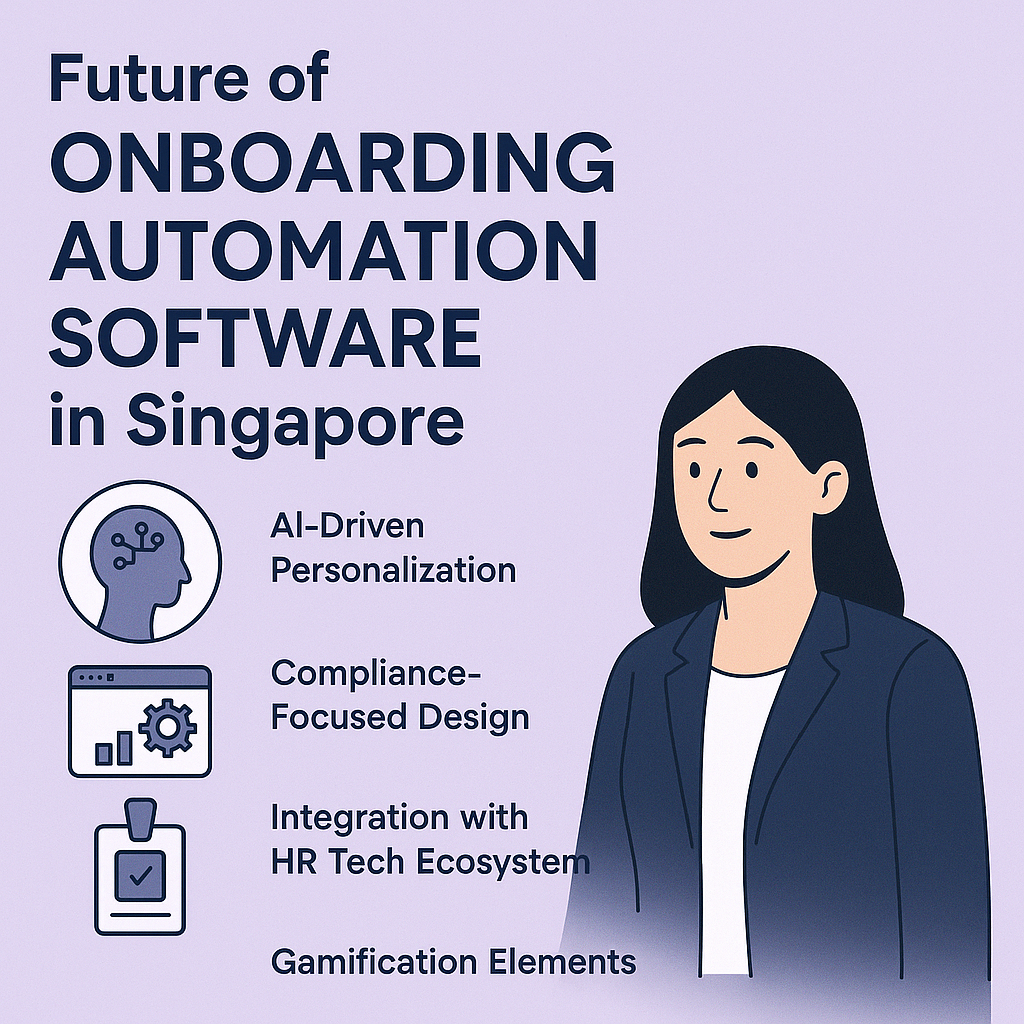
Compliance-First Design: With evolving data privacy regulations, software will prioritize secure document management and data protection to mitigate compliance risks.
Onboarding Gamification: Introducing gamified elements, such as quizzes and interactive modules, can make onboarding more engaging and reinforce critical information.
AI and Predictive Analytics: Anticipating potential drop-off points in the onboarding process.
Personalized Onboarding Journeys: Using data to customize training paths and task assignments.
Integration of Learning Management Systems (LMS): Embedding continuous learning opportunities throughout the onboarding period.
Frequently Asked Questions (FAQ)
What is Onboarding Automation Software?
It is a digital platform that automates the onboarding process, reducing manual work and enhancing new hire experiences.
How does it improve employee retention?
Structured onboarding improves engagement, accelerates productivity, and reduces early turnover.
Is it suitable for remote or hybrid teams?
Yes, most platforms offer remote access, enabling seamless onboarding regardless of location.
Conclusion
Onboarding Automation Software is more than a time-saving tool—it is a strategic asset that enhances the employee experience, ensures compliance, and drives long-term retention. By leveraging data-driven insights and AI-powered tools, organizations can transform their onboarding processes into a structured, engaging, and efficient experience for every new hire.
HR Glossary: Master the Language of Modern HR
From recruiting candidates to onboarding new team members, MokaHR gives your company everything you need to be great at hiring.
Subscribe for more information

